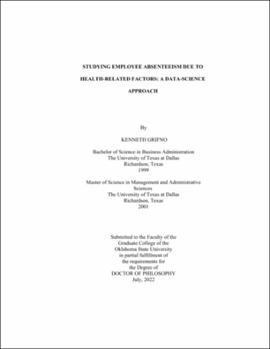| dc.description.abstract | United States employers are spending approximately $950 billion on healthcare benefits, and these costs are impeding their ability to compete in their respective markets. Furthermore, these costs do not include employee absenteeism—the cost of failing to show up for scheduled work. Research has shown that the primary reason for employee absenteeism is poor health. However, management research has primarily focused on controllable factors related to avoidable absences (e.g., job burnout, work attitudes, and personality characteristics). Therefore, the critical issue I address in this dissertation is: How can employers understand, predict and decrease the effect of absenteeism related to the health conditions of their workforces? | |
| dc.description.abstract | A data-science approach was used to explore this critical question, focusing on the leading cause of disability, musculoskeletal disorders (MSDs), and how they impact employee absenteeism. First, I created a well-formed combined dataset using advanced data preparation methods on the datasets of three self-insured employers, their medical claims, pharmacy claims, human resource records, and attendance data. Next, I ran machine learning algorithms to examine the prediction accuracy and the most probable risk factors influencing employee absenteeism related to the health condition. For example, factors influencing the risk of increased absence related to poor health include demographic features of the employees and their position (e.g., age, gender, salary, department, and workload), existing health conditions at the time of absence (e.g., diabetes, behavior health, arthritis, cardiac, and gastrointestinal), treatments for the health condition (e.g., drug, physical therapy, non-surgical procedures, and surgical procedures), and other medical-related variables (e.g., provider types, locations, imaging, labs, and tests). The impact of time was also investigated to obtain treatment information because research indicates that shorter wait times correlate with better outcomes for MSD treatments. A post hoc analysis was conducted to compare the essential variables that predict long-term employee absenteeism to the critical variables that predict high medical costs. It provides important insights into which sorts of healthcare services are connected with a quality outcome (e.g., lower employee absence). | |
